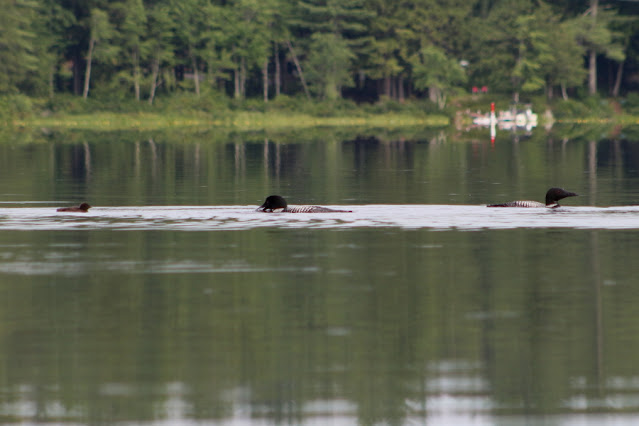Wednesday night the Loon Preservation Committee decided to attempt to band the new loon pair (Maddie's parents) that has taken up residency in Harris Cove. I've assumed this is the same pair that has been on the lake since 2016 but without bands we don't really know. A team of four from the LPC arrived by boat and were joined by a few Lake Wicwas volunteers. The team staged on the Thorpe's beach who kindly allowed the activity to take place there.
 |
| Amy Wilson calms the male loon for banding. (Banding photos by Amy Wilson, Russ Brummer, and Scott Powell) |
The loon family was very accommodating, close together and visible from the staging area in the dimming twilight, and we did our best to keep an eye on them until it was dark enough to attempt a capture. (Banding can't be done in day light or even with a full moon because the loons see the boat coming and swim away.) With the arrival of total darkness they set out in the boat with a spotlight and a large net.
A white breast on a dark lake stands out like a beacon in the spotlight and the family was quickly located. As the boat approaches, loons tend to freeze like a deer in headlights, and one parent was gently scooped up in the net and then quickly wrapped in a soft towel to prevent it from injuring itself or the biologists. The second loon was left to watch over the chick.
Once on shore the bird was quickly measured, and by the dimensions of the leg measurements, it was deduced this was the male.
 |
| The length and width of the left and right tarsus bones were measured. |
Bands of the proper size to fit on each leg were selected and carefully placed.
 |
| A unique combination of colors will identify each loon. |
Next a blood sample was taken to test for lead as well as other factors.
The scene was what I envision a military MASH unit looks like.
 |
Feathers were carefully clipped from the tail and one wing - a very specific feather: one of the secondaries, without which it can still fly. The feathers will be tested for mercury among other things.
 |
| Locating the correct secondary feather to clip. |
 |
| Clipping a tail feather. Note the silver band which has the bird's ID number on it. |
Note that clipping feathers doesn't hurt the birds; it's like us cutting hair or fingernails.
Finally the bird was weighed and then released right at the shore and within minutes it was back with mom and chick. All of the data was carefully recorded along with the band colors and numbers.
After a short wait the team went back out see if they could collect the female as well, which they accomplished just as quickly as the first capture, and were also able to catch Maddie!
 |
| Maddie, 11 days old, the ideal age to band new parents. |
Mom was a little more stressed out than dad was, perhaps because she could hear Maddie calling on occasion, so the female was measured, banded, and weighed quickly, and returned back to the lake - no feathers were collected from her.
 |
| Russ Brummer holds the female for banding. |
This time the two loons (mom and Maddie) were taken out in the boat to the vicinity of the male loon to make sure mom and chick would stay together, and within a few minutes the family was calling and reunited. I wonder what goes through their heads after that experience - it must feel like being abducted by aliens, taken to their spaceship for examination, and then being released.
You probably noticed people are wearing masks. That's not due to covid, but rather to protect people from an avian flu that is present in New England. It's most prevalent in birds that spend time in large flocks such as geese, but it's a simple precaution worth taking. The event ended just before midnight, at which point the LPC team was heading off to another lake to repeat the whole procedure. It's a busy time for a loon biologist!
It was a very successful night on Lake Wicwas and now all four of our nesting loons are identifiable. If you are ever at the ocean in winter, keep an eye out for loons and if you see one, look for bands. It would be interesting to know where our loons spend the winter!
The following morning I went out to check on the family and I found them all together, happily fishing for breakfast.
The parents were mostly bringing small fish to Maddie along with an occasional piece of vegetation - she must eat her vegetables you know.
At one point mom brought a fish to Maddie that was far too big for her. (It's nice to know which parent was doing each feeding.)
 |
| Bringing in an oversize fish for Maddie. |
 |
| Mom watches carefully to make sure Maddie doesn't choke on the oversize fish. |
So eventually mother kept it for herself.
 |
| Even for mom it was quite a mouthful. |
At one point I saw dad rise up and spread its wings and I could clearly see the spot left by the missing secondary feather that was clipped the night before.
 |
| "Wow dad, you're big." Note the white spot on the right wing where the missing secondary feather should be. |
.JPG) |
| "Will I ever be like you?" |








No comments:
Post a Comment